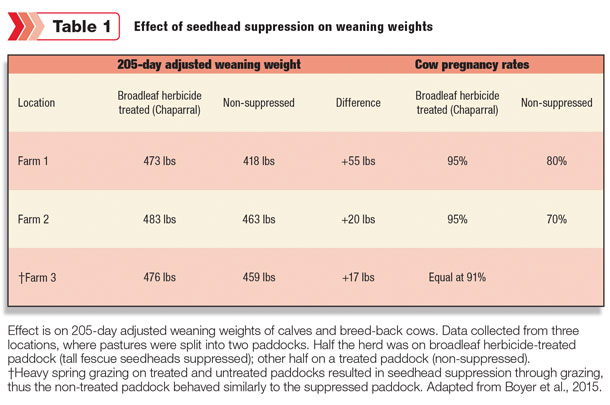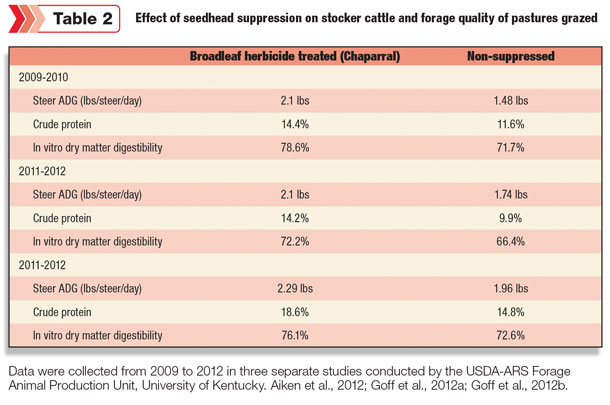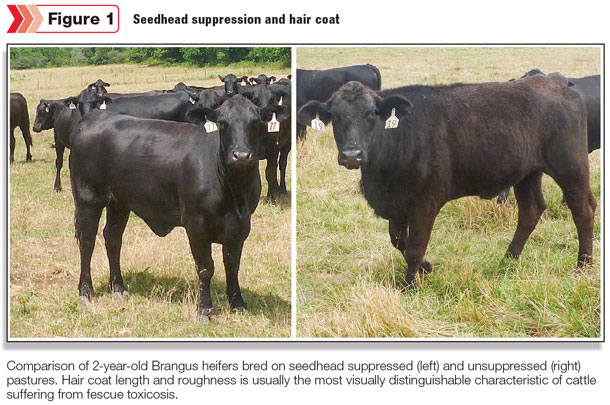Soon after its adoption, cattle producers began to notice a reduction in animal performance and signs that animals were heat-stressed following tall fescue consumption. These symptoms were an indication of an animal disorder that would later be called “fescue toxicosis.”
In the late 1970s, it was discovered that the cattle health issues with tall fescue were actually caused by a fungus (Neotyphodium coenophialum) living within some plants which produced a toxic class of compounds termed ergot alkaloids. We refer to these tall fescue plants that contain this fungus as being endophyte-infected (E+) and those that do not as being endophyte-free (E-).
Fescue toxicosis is estimated to cost the livestock industry $1 billion annually. Economic losses are largely associated with reductions in pregnancy rates, milk production and average daily gains in stocker cattle, poor calf weaning weights, lower sale prices due to the unthrifty appearance of cattle and higher receiving costs for feedlots when fescue toxicosis-stressed animals are delivered.
Seedhead suppression
Appropriately timed spring applications of a broadleaf herbicide (containing aminopyralid and metsulfuron-methyl) on tall fescue pastures inhibits grass maturation, keeping the plants in a vegetative state for the remainder of the growing season.
Both day length and temperature can affect seedhead emergence in tall fescue. Day length of 12 hours or more triggers seedhead formation, and temperature influences grass growth and development.
With this in mind, it is best to apply a broadleaf herbicide starting within three weeks before seedhead emergence to when tall fescue is in the boot stage. Application outside of this window may result in less or no seedhead suppression.
Benefits of seedhead suppression
When seedheads are suppressed and weeds are controlled with a broadleaf herbicide, an increase in grass species diversity is usually observed.
This increase in diversity, along with the better nutritive value of suppressed tall fescue and reduced consumption of ergot alkaloids, has led to higher pregnancy rates in cows and higher 205-day adjusted weaning weights in their calves (Table 1) and improved average daily gains in steers (Table 2).

Tall fescue pastures where seedheads have been suppressed by a broadleaf herbicide have higher crude protein, in vitro dry matter digestibility and water-soluble carbohydrates than untreated pastures.

In addition, herbage dry matter intake by cattle is greater and cattle hair is shorter and smoother compared to cattle feeding on tall fescue not treated with a broadleaf herbicide (Figure 1).
Seedhead suppression in your operation
Seedhead-suppressed tall fescue maintains higher forage quality in spring and early summer when compared to unsuppressed tall fescue. This can allow cattle producers to keep up with spring grass production and maintain availability of high-quality forage for a longer period during the summer.
It also gives producers the ability to rotate to higher-quality fescue pastures during a time of year when tall fescue is usually more mature and has low forage quality.
For tall fescue pastures where a broadleaf herbicide is being used to suppress seedheads, it is advised that no more than 50 percent of total acres be treated in a single season; also, applications should not be made on the same acres over two consecutive years.
A broadleaf herbicide will cause some transient tall fescue leaf yellowing; it is not advised that a broadleaf herbicide be used on pastures for seedhead suppression with poor soil fertility, as the length and severity of yellowing will be prolonged.
Seedhead-suppressed pastures produce less herbage mass early in the season due to the lack of seedheads. Herbage mass in suppressed pastures may again decrease in late summer due to increased forage utilization by less-stressed cows and their calves.
It is recommended that producers rotationally graze pastures to prevent overgrazing and implement a spring and fall soil fertility program to maintain pastures with high-quality grass forage. ![]()
Pat Burch, E.S. Flynn and B.B. Sleugh are field research scientists with Dow AgroSciences.
References omitted due to space but are available upon request. Click here to email an editor.

-
Pat Burch
- Field Scientist
- Dow AgroSciences
- Email Pat Burch







